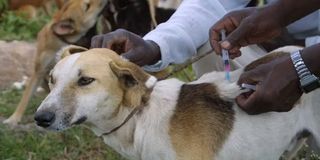Access to rabies vaccines can save thousands of lives, research finds

Vaccinating domestic dogs is a successful and cost-effective way to prevent rabies in dogs. PHOTO | COURTESY
What you need to know:
- The study findings point to a significant opportunity to reduce rabies-related deaths by reforming how vaccines are delivered and administered — especially in rural and underserved areas.
Iringa. A new modelling study has revealed that improving access to post-exposure prophylaxis (PEP) and enhancing vaccine delivery systems could save thousands of lives annually in Tanzania and Kenya.
According to the US National Institute of Health, post-exposure prophylaxis (PEP) is the use of antiretroviral medications to prevent HIV infection after a potential exposure. It's a short course of HIV medicines taken within 72 hours of a possible exposure to prevent the virus from taking hold.
The study findings point to a significant opportunity to reduce rabies-related deaths by reforming how vaccines are delivered and administered — especially in rural and underserved areas.
Published in the journal Vaccine, the study shows that switching to the World Health Organisation (WHO)-recommended intradermal (ID) vaccination method could reduce vaccine usage by over 50 percent. The ID method allows a single vial to treat multiple patients, cutting wastage and helping to prevent stockouts — a common challenge in remote health facilities.
Researchers say the changes would not only protect more people at risk of rabies exposure but also improve the efficiency of national health budgets.
The study was conducted by the University of Glasgow, Ifakara Health Institute, the University of Nairobi’s Centre for Epidemiological Modelling and Analysis (CEMA), the University of Edinburgh, and Washington State University, with support from the Wellcome Trust.
Rabies remains one of the deadliest diseases globally, causing an estimated 59,000 deaths each year — many of them in low- and middle-income countries. Despite the availability of effective treatment, barriers such as high costs, limited access, and unreliable vaccine supply continue to hinder timely care.
The study used real-world data from health systems in Kenya and Tanzania to assess how supply chain management, vaccine demand, and delivery strategies could be improved.
The researchers found that clinics treating multiple bite patients daily could adopt the dose-sparing intradermal method to protect more individuals with fewer doses. By decentralising services from central hospitals to more local health centres, and by tailoring restocking plans to actual demand, access could be significantly improved.
The study’s lead author and a postgraduate researcher at the University of Glasgow, Ms Martha Luka, said it was unacceptable that people were still dying from a preventable disease like rabies.
She stressed that simple changes — such as adopting intradermal injections and improving vaccine stock management — could lead to life-saving results.
In Tanzania, where PEP is largely available only in central hospitals, decentralisation was highlighted as key to ensuring equitable access. The study proposes setting-specific rules to help clinics maintain adequate stock levels and respond to sudden increases in demand.
A co-author and researcher at the Ifakara Health Institute, Mr Kennedy Lushasi, said the findings provide a practical roadmap for improving how rabies vaccines are delivered.
He called on public health leaders and policymakers to act swiftly to implement the recommendations.




